 |
Fort Desaix
Fort-de-France, Martinique
|
|
 |
Constructed: 1768-1772
Used by: France, Great Britain
Conflict in which it participated:
Napoleonic Wars
Also known as: Fort Bourbon,
Fort la Convention, Fort George
|
Explorer Christopher Columbus (1451-1506) charted the location of Martinique in 1493 and landed there in 1502 (Columbus was also responsible for naming the island). The royal Spanish response to this discovery was an unequivocal "meh," so the island was left to its native Taino and Carib peoples until the French first showed up.
Some 150 French folks, recently having been kicked off the island of St. Kitts by the British, landed on Martinique on September 15, 1635. |
 |
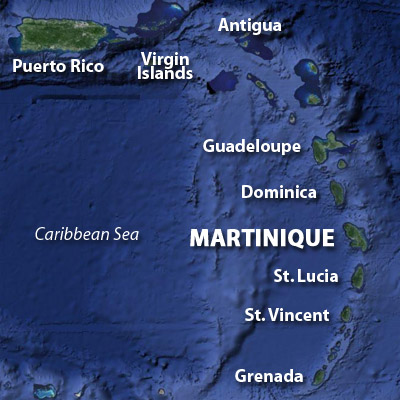 |
|
The French settlers first started fortifying on Martinique in 1638, building and improving what would be called Fort Royal, Fort de la Republique (in revolutionary times) and eventually Fort Saint-Louis. This fort would prove effective against the indigenous population, but not against the British, mostly due to the availability of higher ground nearby on which a wily attacker might (and did) place cannon. The Fort-de-France area would eventually be protected by four forts.
The indiginous Caribs rose against their benevolent overlords on a variety of occasions, but by 1658 the vast majority of criminally non-caucasians had been done away with or driven to other islands.
French Huguenots, always looking for cool places to go to avoid being murdered for not being Catholic in France, became Martinique's principal settlers. French King Louis XIV (1638-1715) thought that Martinique was a fine place for Huguenots to be, so around a thousand of them were shipped to the island from 1686 to 1688 under miserable, often fatal shipboard conditions. Once the emaciated survivors of this journey arrived at Martinique and were presented to the established Huguenot planters for indentured servitude, however, the planters said something akin to "l'Enfer avec cette" and left Martinique en masse for the Protestant colonies of North America. This decimated the population of Martinique, which not only killed the sugar production that France was enjoying, but left the island vulnerable for occupation by Great Britain.
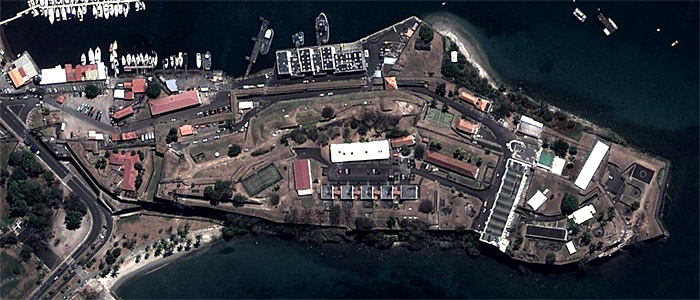 Fort Saint-Louis, built from 1638 to 1672. This fort, built with the Vaubanesque concept of letting the land define the shape of the fort taken to a painfully literal degree (this is not a starfort: For shame, France), was able to deflect a Dutch attack in 1674 and a British attack in 1759. In 1762 the British returned, put guns on the nearby high ground of Morne Garnier, and bombarded Fort Saint-Louis to surrender...and with it the island of Martinique. During the frequent periods of British rule of Martinique, this fort was known as Fort Edwards.
Though I am personally unhappy that Fort Saint-Louis is not a proper starfort, it was poor siting, and not non-starfortitude, that made it unsuccessful against the ever-resourceful British in 1762, during the Seven Years' War (1754-1763). Once the British placed cannon on the nearby high ground overlooking Fort Saint-Louis (in fairness to the fort's designers, the existence of cannon with the portability and range to fire on Fort Saint-Louis from those heights must have been unthinkable in 1638) and done some pounding, the fort and island capitulated.
|
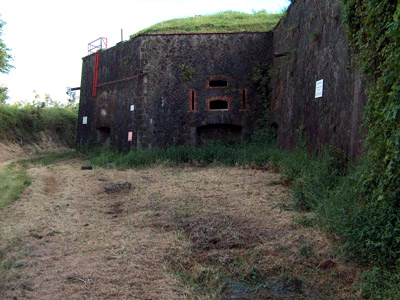 Click on it, it's huge. Note the masonry, and how random the placement of the individual stones seems to be! It all ends up with the perfectly flat face that one would desire in a starfort, but compare it to the carefully-placed symmetric blocks of any American starfort (such as those of Fort Delaware), and it seems...messy. Click on it, it's huge. Note the masonry, and how random the placement of the individual stones seems to be! It all ends up with the perfectly flat face that one would desire in a starfort, but compare it to the carefully-placed symmetric blocks of any American starfort (such as those of Fort Delaware), and it seems...messy. |
 |
Martinique was occupied by Britain for the rest of the war but was returned to the French in 1763. Shortly thereafter the blind spot in Fort-de-France's defenses (the high ground that the British had so gleefully exploited) was addressed with the start of the fortification of Morne Garnier, in 1768. This more properly starforty fort was named Fort Bourbon, after the ruling house of France.
The French Revolution (1789-1799) brought about both a great many decapitated persons and the ritual re-naming of everything French. Fort Bourbon became Fort la Convention. What a pain it must have been to have to remember everything's new, non- monarchial name or else be guillotined! |
|
|
Though this fort, which is the fort of our current interest, most certainly dominated all below it, it nonetheless proved tragically unequal to the efforts of Great Britain. French King Louis XVI (1754-1793) had been guillotined in 1793, touching off a great deal of furious thrashing about by Europe's hurt and saddened (but mostly threatened) monarchies. One result of these thrashings was the attack of Martinique and subsequent siege of Fort la Convention by the British Royal Navy, in March of 1794.
|
Fort la Convention, or at least part of it (a large lunette, or half-moon-shaped space that sounds suspiciously like a casemate, had been built in 1780 in front of the fort, linked to the fort by a covered way...that element proved to be far more resistant to bombardment than the rest of the fort), held out for 14 days.
Great Britain possessed Martinique from 1794 to 1802 and then 1809 to 1815. One imagines that they gave Martinique back to the French in 1802 just so they could have the fun of attacking, besieging and defeating Fort Desaix again!
|
 |
 A depiction of the British attack on Fort de France in 1794. A depiction of the British attack on Fort de France in 1794. |
|
...because the French had held Martinique just long enough for Napoleon (1769-1821) to personally change the name of our fort to Fort Desaix! Louis Desaix (1768-1800) had been a French general and close confidant of Napoleon's who had died in action, in Italy in 1800. A number of other things were named for Desaix (including several ships), and his name is carved in the face of the Arc de Triomphe, along with the names of other important military figures of the French Revolution, in Paris. The British attack of 1809 took place from February 10 - 24, during which nearly all of Fort Desaix's 98 guns were dismounted under the British bombardment, and 200 of the fort's garrison were killed. This time the British, who referred to it as Fort George while they were in town (Honestly, Britain. There are other names for forts out there: Witness Fort George in Scotland and Fort George in Canada), decided they'd conquered this fort quite enough, and demolished it. Martinique was returned yet again to French control in 1815, with Fort Desaix in a much diminished state.
|
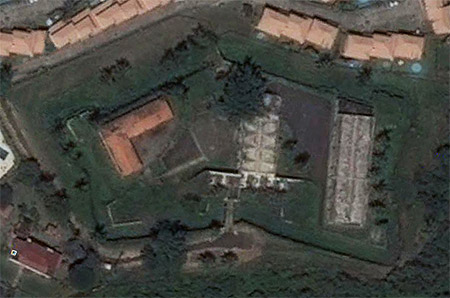 Fort Tartenson: The shape of late-19th-century European forts, when stars just weren't good enough any more. Fort Tartenson: The shape of late-19th-century European forts, when stars just weren't good enough any more. |
 |
Fort Desaix was rebuilt in 1848, and then refitted in 1880 and 1905 to mount the bigass coastal guns that were all the rage with industrialized nations at the time. Two additional forts, Fort Tarteson and Fort Gerbault, were built at Fort de France in the 19th century, taking advantage of other hilly areas overlooking the port.
Fort Tartenson, named for a French family that had settled on Martinique in the 17th century, was built from 1857 to 1873. This fort remained armed and in service until 1939. |
|
|
From 1894 to 1898, the exiled king of the African nation of Dahomey (now Benin), Béhanzin (1845-1906) and his family, lived at Fort Tartenson (in "huts") after being booted from his throne by the French. Hey, thanks for these awesome huts, France.
Today, Martinique exists as an "overseas department" of France, and is considered an actual, far-flung region of Europe. A French naval base remains at Fort-de-France, and two active companies of French troops are stationed at Fort Desaix, ever ready to be bombarded and conquered by the British for the umpteenth time.
|
Our lovely, Vauban-y Fort Desaix of Fort-de-France is not to be confused with the Fort Desaix near Mundolsheim, France. It was built in the 1870's at the command of Prussian bigshot Helmuth von Moltke the Elder (1800-1891) as one of a planned 36-fort ring around the city of Strasbourg, which the Prussians had snatched from the French during the Franco-Prussian War (1871). |
 |
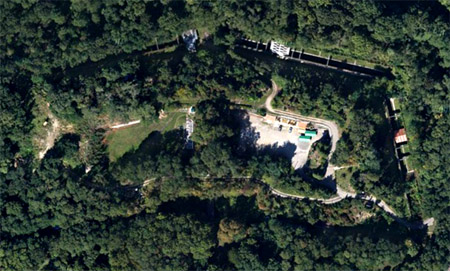 The other Fort Desaix. Ridiculous. |
|
|
Originally named Fort Roon after Prussian soldier and statesman Albrecht Theodor Emil Graf von Roon (1803-1879), this is one of the ridiculous squashed-hexagonal "artillery forts" that popped up in large numbers around Europe toward the end of the 19th century. The artillery fort concept was what replaced the starfort, so naturally artillery forts offend me deeply.
Only fourteen of the planned 36 Strasbourg-defendin' forts were ever built. Once France regained the Alsace region (in which this fort is situated) from Germany after the First World War (1914-1918), the fort was renamed Fort Desaix. In the words of the French Wikipedia page describing this other, lesser Fort Desaix, It now houses a shooting.
Thanks to Caribbean starfort watcher Nils Jergensen for finding Fort Tartenson for me!!
|
|
|
|
|
|
 |




